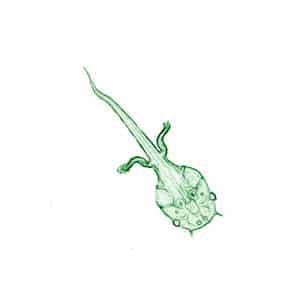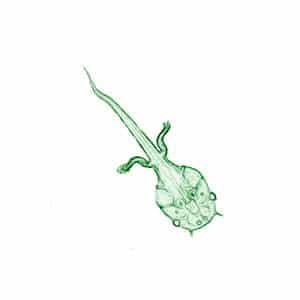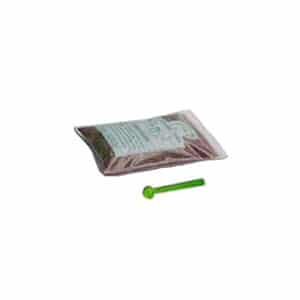Live Tadpole
-
Hind Limb Stage
-
Morphs AWESOME FAST ( 21 days average )
-
Good to Grow!
PLEASE NOTE: Your HIND LIMB Stage Tadpole will be sent with back legs emerged.
Hind limb tads morph FAST and are sent like ‘rose buds ready to bloom.’
( in some cases due to the rapid rate of growth the HIND LIMB tadpole may arrive small front limb buds)
WE ASLO Offer NO LIMB tadpoles! No limb tadpoles are much younger, require a minimum a 3 gallon of water per tadpole and take MUCH longer to morph (8 – 12 weeks on average).
Change is GOOD!
You won’t observe THIS much change anywhere else!
Your students will THRILL to the DAILY observation of change. Live tadpole TO baby frog in just 21 days!
Growafrog PROUDLY provides your classroom with see thru, captive bred live tadpoles so your students may fulfill classroom core curriculum requirements
AND
allow native diminishing tadpole populations to remain ‘in the pond and undisturbed.’
We offer ‘more than a few’ Growafrog kits with habitats however if you are just interested in the ‘star of the show’ we invite you consider ordering ‘just a live tadpole’ and use your own habitat!
EVERY KID should observe a tadpole morph into a frog!
Tadpoles develop from eggs! Before your tadpole can swim and eat on its own it ‘hatches’ from an egg. Adult frogs lay eggs in ‘clusters.’ If you have ever seen caviar (fish eggs) – then frog eggs superficially ‘look similar.’
Frogs lay eggs in ‘strings.’ Christmas ‘string lights’ ‘sort of’ are an analogy for how frogs lay eggs. The eggs are ‘attached’ to each other by a ‘string-like’ coat of clear ‘jelly’ which protect the eggs. Just like Christmas ‘string lights’ the frog egg strings can and do ‘wrap around each other.’
Sometimes eggs look like a big blob yet upon closer observation they are simply one very long string of eggs.
Female frogs are always ‘gravid’ – meaning that adult female frogs always have eggs. When frogs mate, the adult male gives the adult female a big HUG!
This ‘hugging’ behavior (called amplexus) can last for 12 or more hours!
EGG Development
Frog eggs begin development after they are fertilized.
The string of eggs is laid in the water.
Each egg is ONE CELL (a VERY BIG CELL!) In contrast, most cells are NOT visible with the naked eye and are ONLY visible with a microscope.
After fertilization the remarkable process of this one LARGE cell will transform unbelievably into MILLIONS of microscopic cells – that’s EVERY cell in the frog!
In about 12 hours after fertilization the one cell DIVIDES into TWO identical cells!
It is remarkable what you can learn about BIOLOGY from a frog!
The cells keep dividing and dividing!
Two cells divide again – so now the egg is has 4 cells. Again the cells divide – so there is an 8 cell stage, a 16 cell stage, and a 32 cell stage. When the egg reaches the 32 cell stage it ‘kinda sorta’ looks like a blackberry – very round yet ‘divided.’
The cells keep dividing until they number approximately 10,000 cells. However, as they are much smaller of course the individual cells are no longer visible with the naked eye.
It is a remarkable process!
Folding and Lots More Folding
Then the ‘simple’ cell division STOPS! After about 24 hours the cells start to ‘become different’ They are no longer identical. Let the folding begin!
All of the cells in the entire round egg start folding and moving very rapidly! Its kind of like when you take a matching pair of socks and put them together and then fold them ‘inside out.’
The outside becomes the inside.
This process (called gastrulation) creates the three separate skin layers
- outer layer (ectoderm)
- middle layer (mesoderm)
- inner layer (endoderm)
Hatching ( 72 hours after fertilization )
The process of elongation and differentiation continues! Cells keep moving to relatively quickly create a swimming developmental stage called a LARVAE! Larvae superficially look like miniature ‘ice cream sprinkles’ – they are much longer than they are wide.
HAPPY HATCH DAY! YEAH !!!
Larvae have eyes, a tail, and a yolk sac. The larvae ‘hang out at the top of the water’s surface. The get ALL of their nutrition from the yolk sac. That YOLK sac is from the yolk of the egg.
Yes, frog eggs have yolk just like your breakfast chicken egg!
Larvae ‘do not do much.’ They just hang put at the surface. However, inside they are still developing into a little baby tadpole that no longer has a yolk sac and EATS on its own!
Here at Growafrog – we grow larvae into the larger live tadpole (pictured above) you will receive when you order your tadpole online.
Our captive bred facilities have live tadpoles for sale ‘on demand’ to meet the very important needs of your classroom curriculum!
You may easily buy tadpoles online at Growafrog.com as we can provide your students with a live tadpole in multiple stages of development.
Options are easily available to purchase a Growafrog live tadpole kit such as the popular Tadventure Kit (which includes ‘everything’ ) or to simply order a live tadpole individually.
Order tadpoles for your classroom so that your students may LEARN about natural history!
Where do you get tadpoles? Why, of course at the Official Site of Growafrog tadpoles and frogs – Growafrog.com.
How much do tadpoles cost? The Growafrog Kit is your least expensive option for purchasing a tadpole kit ! Cost is just 42.95 – FREE SHIPPING!







